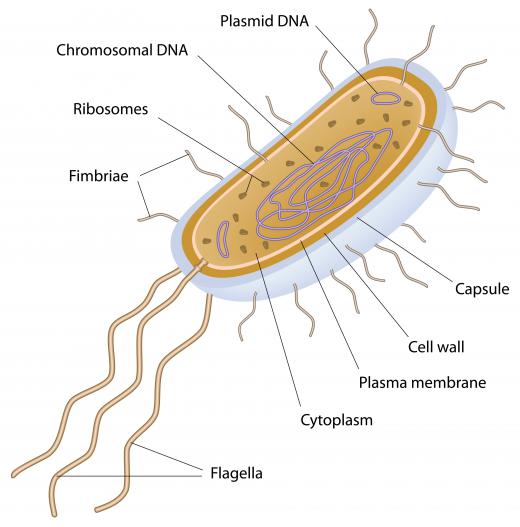What are Prokaryotes?
 Michael Anissimov
Michael Anissimov
Prokaryotic cells are primitive cells that lack a nucleus. Instead of storing genetic material in well-organized chromosomes protected by a membrane-bound nucleus, prokaryotes store their genetic material in an irregularly shaped "nucleoid" that is composed of 60% DNA. Substantial DNA is also stored in small organelles outside the nucleoid called plasmids, which are little rings of genetic material (1-400 kilobases) that are copied along with the normal process of cell division and can also be exchanged between prokaryotes. Plasmid exchange is partially responsible for the ability of prokaryotes to quickly adapt to external threats such as antibiotics.
Prokaryotes encompass the Bacteria and Archaea domains, which are two of the three domains of all life, the other being Eucaryota, which contains all the multicellular organisms with which we are familiar. Most prokaryotes are free-floating and independent, though some form various types of colonies, and the cyanobacteria even exhibit some degree of cell differentiation which can be interpreted as primitive plantlike features such as stalks, vines, etc.

The division between eukaryotes and prokaryotes is considered to be the most significant division in the entire kingdom of life. Simple prokaryotes of the domain Archaea have existed for 3.8 billion years or longer, whereas eukaryotes have only existed for about 600 million years - a difference of more than a factor of six. Many astrobiologists and space enthusiasts hope to find eukaryotic life on other planets, where conditions are too extreme for the emergence of prokaryotic life to be very likely. One oft cited potential location is the methane lakes of the Saturnian moon Titan.
Possibly the greatest accomplishment of the prokaryotes was what made other forms of life possible - the mass conversion of atmospheric CO2 to oxygen. This happened around 2.4 billion years ago and has been termed the Oxygen Catastrophe, because it caused mass extinction among organisms not adapted to breathing the new air. We can pinpoint the date of the Oxygen Catastrophe because its occurrence led to the oxidation of the majority of free iron on the surface of earth, producing a sharp transition from iron to rust in the strata layers.
AS FEATURED ON:
AS FEATURED ON:











Discuss this Article
Post your comments